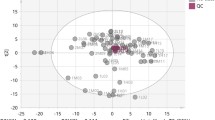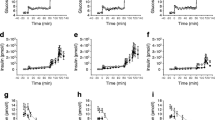Abstract
Glucocorticoid-induced glucose intolerance and insulin resistance are dependent on the type of steroid, its dose and route of administration. Although the intravenous (i.v.) route is used mainly, the effects of different steroids have so far been compared using the oral route. The present study was therefore planned to compare the effects on glucose metabolism of hydrocortisone (HC) and methylprednisolone (MP) administered i.v. at equivalent antiinflammatory doses in healthy subjects.
Eighteen healthy volunteers with normal glucose tolerance, divided into three groups (A,B,C) matched for age, sex and body mass index were subjected to oral glucose tolerance tests (oGTT) 12 h after HC or MP i.v. injection. The two tests were performed at a 1-month interval and in random sequence. Group A received low doses (HC 100 mg, MP 20 mg), group B intermediate doses (HC 200 mg, MP 40 mg) and group C high doses (HC 400 mg, MP 80 mg). Serum glucose, insulin and C-peptide were measured during both fasting and oGTT.
Serum glucose values were not significantly different after HC or MP, during both fasting and oGTT. However, there was a positive correlation between fasting serum glucose or the area under the glucose curve and the dose·kg−1 body weight of HC (r=0.748; r=0.462) and MP (r=0.708; r=0.736). Serum insulin values were significantly higher after MP than after HC when fasting (A: 115 vs 223; B: 95 vs 215, C: 158 vs 268 pmol·l−1) and as area under the oGTT curve (A: 57.8 vs 87; B: 48.5 vs 92.1; C: 57.8 vs 94.5 pmol·l−1·2 h). In contrast, serum C-peptide values were not significantly different after HC or MP, neither fasting nor as area under the insulin curve. Fasting C-peptide/insulin molar ratio was significantly lower after MP than HC at the three doses administered.
In conclusion the dose-related decreases in glucose tolerance are more marked after a single i.v. injection of MP than HC at the same anti-inflammatory dose, MP 20 or 40 mg as well as HC 100 or 200 mg do not impair glucose tolerance, but the former is associated with higher serum insulin levels, suggesting insulin resistance. MP-induced hyperinsulinaemia seems to be mainly due to reduced hepatic insulin extraction.
Similar content being viewed by others
References
Anonymous (1984a) Adrenals. In: American Hospital Formulary service, drug information 1984. American Society of Hospital Pharmacists, Bethesda, Md
Anonymous (1984b). Adrenocorticoids (systemic). In: 1984 USP drug information for the healthy care provider, vol I. United States Pharmacopeial Convention 1984, Rockville
Bonora E, Zavaroni I, Coscelli C, Butturini U (1983) Decreased hepatic insulin extraction in subjects with mild glucose intolerance. Metabolism 32: 438–446
Bruno A, Cavallo-Perin P, Cassader M, Pagano G (1987) Deflazacort vs prednisone: effect on blood glucose control in insulintreated diabetics. Arch Intern Med 147: 679–680
Bruno A, Pagano G, Benzi L, Di Ciani G, Spallone V, Calabrese G, Passeri A (1992) Change in glucose metabolism after long-term treatment with deflazacort and betamethasone. Eur J Clin Pharmacol 43: 47–50
Cavallo-Perin P, Bruno A, Ozzello A, Dall'Omo AM, Lombardi A, Cassader M, Imbimbo B, Pagano G (1984) Comparison of acute and subacute effects of deflazacort and prednisone on glucose metabolism in man. Eur J Clin Pharmacol 26: 357–362
Chap Z, Jones RH, Chou J (1986) Effect of dexamethasone on hepatic glucose and insulin metabolism after oral glucose in conscious dogs. J Clin Invest 78: 1355–1361
Crake T, Crisp AJ, Shearing M (1984) Effect of intraluminal hydrocortisone on solute and water absorption in the human jejunum. Clin Sci 67: 105–110
De Pirro R, Bertoli A, Fusco A, Testa I, Greco AV, Lauro R (1980) Effect of dexamethasone and cortisone on insulin receptors in normal human male. J Clin Endocrinol Metab 51: 503–507
Fantus IG, Ryan J, Hizuka N, Gorden P (1981) The effect of glucocorticoids on the insulin receptor: an in vivo and in vitro study. J Clin Endocrinol Metab 52: 953–960
Haynes RC Jr, Murad F (1985) Adrenocorticotropic hormone. Adrenocortical steroids and their synthetic analogs: inhibitors of adrenocortical steroid biosynthesis. In: Gilman AG et al (eds) Goodman and Gilman's The pharmacological basis of therapeutics. Macmillan, New York
Imbimbo B, Tuzi T, Porzio F, Schiavetti L (1984) Clinical equivalence of new glucocorticoid, deflazacort and prednisone in rheumatoid arthritis and SLE patients. In: Avioli LV, Gennari C, Imbimbo B (eds) Glucocorticoid effects and their biological consequences. Plenum Press, New York
National Diabetes Data Group (1979) Classification and diagnosis of diabetes mellitus and other categories of glucose intolerance. Diabetes 28: 1039–1045
Pagano G, Lombardi A, Ferraris GM, Imbimbo B, Cavallo-Perin P (1982) Acute effect of prednisone and deflazacort on glucose tolerance in prediabetic subjects. Eur J Clin Pharmacol 22: 469–471
Pagano G, Cavallo-Perin P, Cassader M, Bruno A, Ozzello A, Masciola P, Dall'Omo AM, Imbimbo B (1983) An in vivo and in vitro study of the mechanism of prednisone-induced insulin resistance in healthy subjects. J Clin Invest 72: 1814–1820
Pagano G, Cavallo-Perin P, Bruno A, Lombardi A, Ozzello A, Dall'Omo AM, Imbimbo B (1984) Deflazacort versus prednisone diabetogenic effect evaluated by glucose clamp and compartmental analysis. In: Avioli LV, Gennari C, Imbimbo B (eds) Glucocorticoid effects and their biological consequences. Plenum Press, New York
Pagano G, Bruno A, Cavallo-Perin P, Cesco L, Imbimbo B (1989) Glucose intolerance after short-term administration of corticosteroids in healthy subjects. Prednisone, deflazacort, and betamethasone. Arch Intern Med 149: 1098–1101
Polonsky KS, Rubenstein AH (1983) C-Peptide as a measure of the secretion and hepatic extraction of insulin: pitfalls and limitations. Diabetes 33: 486–494
Author information
Authors and Affiliations
Rights and permissions
About this article
Cite this article
Bruno, A., Carucci, P., Cassader, M. et al. Serum glucose, insulin and C-peptide response to oral glucose after intravenous administration of hydrocortisone and methylprednisolone in man. Eur J Clin Pharmacol 46, 411–415 (1994). https://doi.org/10.1007/BF00191902
Received:
Accepted:
Issue Date:
DOI: https://doi.org/10.1007/BF00191902




